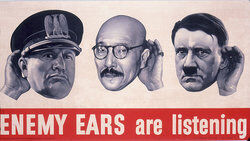
Mussolini, Tojo and Hitler
In simple terms, fascism is defined as a government structure where one dictator has complete control of the entire country, state, or territory. Anyone who opposes this dictator is suppressed and individual rights are often oppressed. A fascist government might also be called totalitarian.
Examples of Fascism in History
While the two main examples of fascism in history involve Mussolini and Hitler, there were many other fascist leaders between 1922 and 1945 when this government structure was most popular.
- 1925-1943: Italy’s National Fascist Party led by Benito Mussolini made Italy a fascist state.
- 1933-1945: Adolf Hitler’s National Socialist German Workers’ Party, or the Nazi Party, ruled Germany under his leadership for 12 years.
- 1932-1934: After being named Chancellor of Austria in 1932, Engelbert Dollfuss had no intention of ending the democracy until he was convinced fascism was necessary for the future of the country.
- 1932-1968: António de Oliveira Salazar joined The National Union in Portugal and ruled for nearly four decades.
- 1935-1945: In Belgium, the Rexist Party had success in winning many parliament seats under the leadership of Léon Degrelle.
- 1937-1938: The French Cross of Fire (Croix-de-Feu) was the biggest and fastest-growing right wing party in France in the late 1930s.
- 1941-1944: Prime Minister Hideki Tojo in Japan rose through military ranks and ultimately became famous as the leader who gave the order for the Pearl Harbor attack in the U.S.
Historical Origins of Fascism
Contrary to popular belief, Benito Mussolini did not invent fascism. The origins of fascist ideas can be traced back to the 19th century in countries like France and Austria.
While these ideas weren’t uncommon, fascism was only successful when the perceived economic threats were such that specific social groups wanted something radically different. Progressive revolutions in different countries from the late 1700s to the early 1800s sparked the original fascist ideas.
Mussolini and Fascism
Ideals of fascism gained support and notoriety in Italy in the 1920s as landowners and businessmen embraced fascism as an oppositional alternative to socialism. This is where Mussolini came in as the “founder of fascism.”
He was expelled from the socialist party for being in favor of strong nationalism. Mussolini, also known as Il Duce (“The Leader”), is considered the world’s first fascist leader. This is because he created the term “fascism” from the Latin term “fasces,” a symbol of punitive authority in ancient Rome. Mussolini then used the term to name his fascist party Partito Nazionale Fascista (National Fascist Party).
Neo-Fascism
At the end of World War II, any major fascist parties in Europe were broken up and even banned. But, this didn’t stop other groups from adopting fascist ideals.
Starting in the late 1940s, neo-fascist groups started to form in Latin America, the Middle East, and South Africa. These groups made efforts to look more democratic than autocratic, and they altered some of their beliefs based on modern, post-war European principles.
Characteristics and Principles of Fascism
It is incredibly difficult to name all the elements of fascism because each fascist leader and party interpreted the ideology in slightly different ways. Some of the most prominent principles and characteristics of fascism include:
- Totalitarian regime: One dictator has total control.
- Extreme militaristic nationalism: An individual’s devotion to the state is strictly enforced.
- Disdain for electoral democracy: Leaders don’t need to be elected from a group of candidates.
- Oppose political liberalism: The government must protect the people at all costs.
- Oppose cultural liberalism: The government must protect a specific culture at all costs.
- Rule of the elites: There’s a natural hierarchy of people.
- Creation of a people’s community: Individual interests are subordinate to the good of the nation.
- Corporatist economy: Society is organized by “corporations” that are subordinate to the state.
- Mass mobilization: Leaders win popular support and power through mass gatherings of the public.
- Oppose decadence: A fascist state fights, by any means, against characteristics like materialism and cowardice.
- Physical force: Violence is deemed necessary to combat opponents.
Differences Between Fascism, Communism, and Socialism
The different types of government structures and types of economic systems are easy to confuse, because there are many blurred lines between them.
Fascism vs. Socialism
If you look at examples of socialism, you’ll see that the main difference between fascism and socialism is that fascism is a type of government structure while socialism is more of an economic structure. Socialism falls somewhere between capitalism and communism.
Fascism vs. Communism
When you examine examples of communism, you’ll see that it is a government structure like fascism and both include government control over certain industries.The main difference between these two ideologies is that fascism embraces a strict class system while communism rejects a class system for the people.
Fascism is a right wing ideology, emphasizing authority, order and hierarchy. By contrast, communism is a left wing ideology, emphasizing concepts like equality, individual freedom and progressive ideas.
Fascism vs. Nazism
Nazism is very similar to fascism, but it takes every characteristic of fascism to the extreme. While examples of fascism can be seen throughout history, Nazism is specific to the the Nazi Party in Germany during the first half of the 1900s.
“Nazi” is an abbreviated form of the German Nationalsozialist. Even though the party’s name contains the term “socialist,” its actual ideals were almost the complete opposite. As mentioned above, the term “fascist” derives from the Italian Partito Nazionale Fascista.
A History of Fascism
Look at different examples of dictatorship and you’ll probably see a lot of elements of fascism. While fascism might not be a mainstream ideology in modern times, there are still examples of fascist ideals throughout the world today.